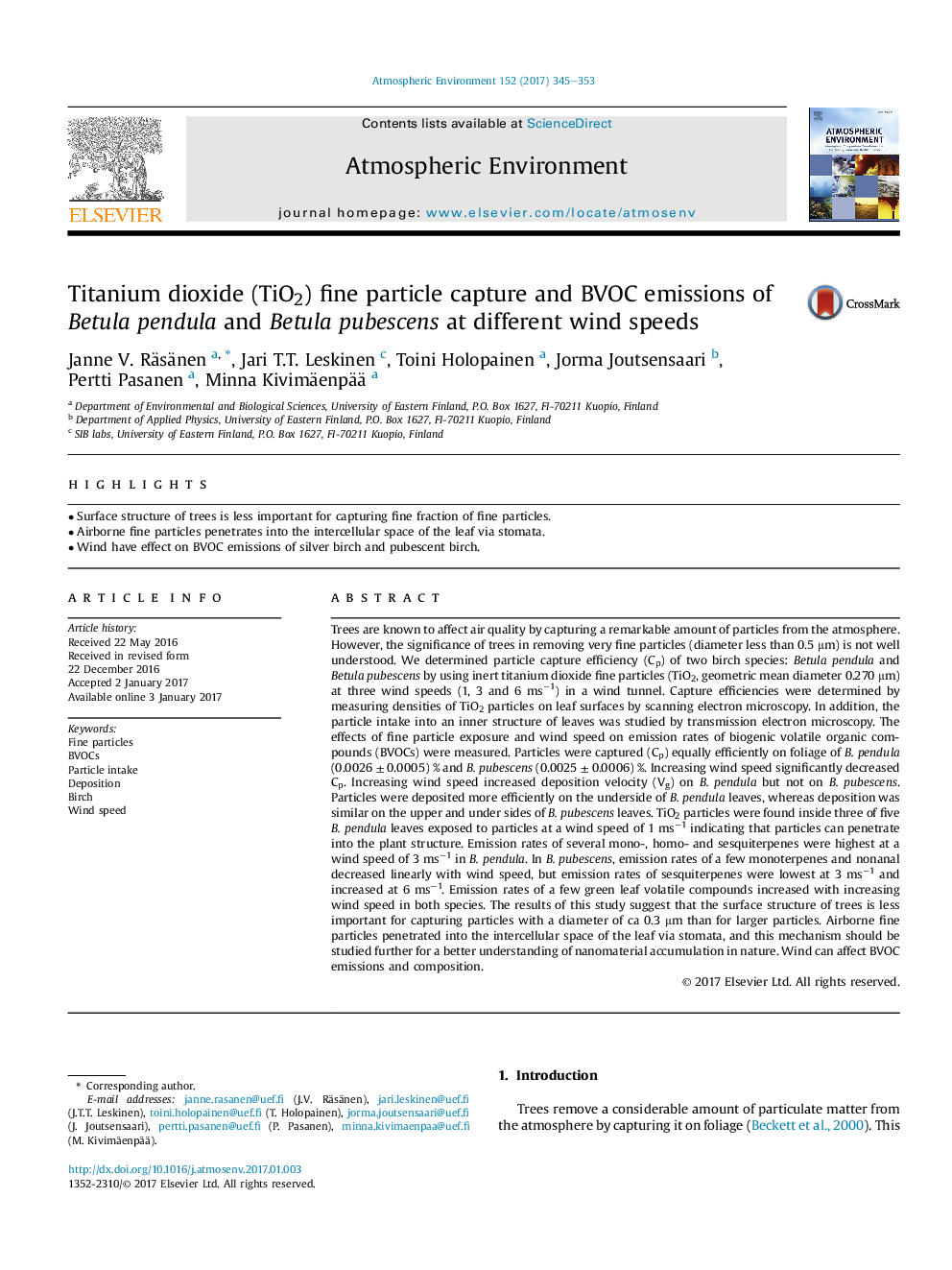| کد مقاله | کد نشریه | سال انتشار | مقاله انگلیسی | نسخه تمام متن |
|---|---|---|---|---|
| 5753412 | 1620322 | 2017 | 9 صفحه PDF | دانلود رایگان |
عنوان انگلیسی مقاله ISI
Titanium dioxide (TiO2) fine particle capture and BVOC emissions of Betula pendula and Betula pubescens at different wind speeds
دانلود مقاله + سفارش ترجمه
دانلود مقاله ISI انگلیسی
رایگان برای ایرانیان
موضوعات مرتبط
مهندسی و علوم پایه
علوم زمین و سیارات
علم هواشناسی
پیش نمایش صفحه اول مقاله

چکیده انگلیسی
Trees are known to affect air quality by capturing a remarkable amount of particles from the atmosphere. However, the significance of trees in removing very fine particles (diameter less than 0.5 μm) is not well understood. We determined particle capture efficiency (Cp) of two birch species: Betula pendula and Betula pubescens by using inert titanium dioxide fine particles (TiO2, geometric mean diameter 0.270 μm) at three wind speeds (1, 3 and 6 msâ1) in a wind tunnel. Capture efficiencies were determined by measuring densities of TiO2 particles on leaf surfaces by scanning electron microscopy. In addition, the particle intake into an inner structure of leaves was studied by transmission electron microscopy. The effects of fine particle exposure and wind speed on emission rates of biogenic volatile organic compounds (BVOCs) were measured. Particles were captured (Cp) equally efficiently on foliage of B. pendula (0.0026 ± 0.0005) % and B. pubescens (0.0025 ± 0.0006) %. Increasing wind speed significantly decreased Cp. Increasing wind speed increased deposition velocity (Vg) on B. pendula but not on B. pubescens. Particles were deposited more efficiently on the underside of B. pendula leaves, whereas deposition was similar on the upper and under sides of B. pubescens leaves. TiO2 particles were found inside three of five B. pendula leaves exposed to particles at a wind speed of 1 msâ1 indicating that particles can penetrate into the plant structure. Emission rates of several mono-, homo- and sesquiterpenes were highest at a wind speed of 3 msâ1 in B. pendula. In B. pubescens, emission rates of a few monoterpenes and nonanal decreased linearly with wind speed, but emission rates of sesquiterpenes were lowest at 3 msâ1 and increased at 6 msâ1. Emission rates of a few green leaf volatile compounds increased with increasing wind speed in both species. The results of this study suggest that the surface structure of trees is less important for capturing particles with a diameter of ca 0.3 μm than for larger particles. Airborne fine particles penetrated into the intercellular space of the leaf via stomata, and this mechanism should be studied further for a better understanding of nanomaterial accumulation in nature. Wind can affect BVOC emissions and composition.
ناشر
Database: Elsevier - ScienceDirect (ساینس دایرکت)
Journal: Atmospheric Environment - Volume 152, March 2017, Pages 345-353
Journal: Atmospheric Environment - Volume 152, March 2017, Pages 345-353
نویسندگان
Janne V. Räsänen, Jari T.T. Leskinen, Toini Holopainen, Jorma Joutsensaari, Pertti Pasanen, Minna Kivimäenpää,